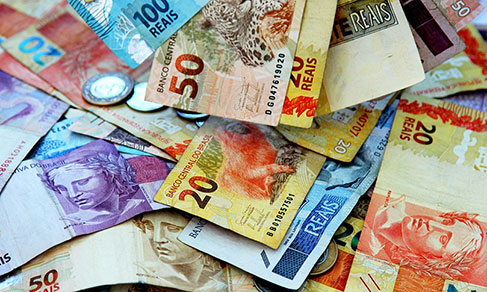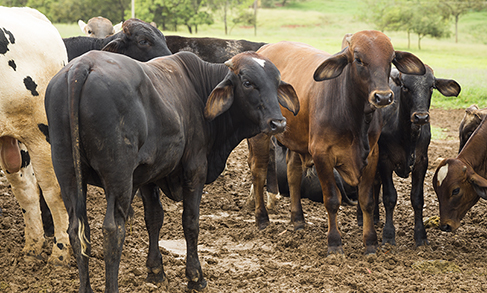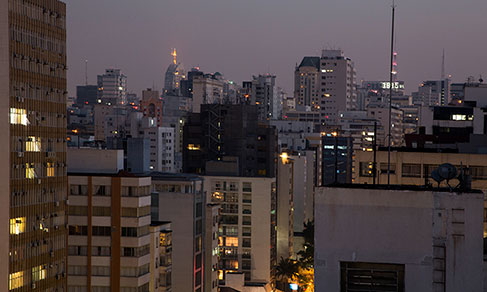Municipal Livestock Survey
Cattle herd increases by 1.5%, with a total of 218.2 million head in 2020
September 29, 2021 10h00 AM | Last Updated: October 01, 2021 02h41 PM
Highlights
- With 218.2 million head, cattle herd increased by 1.5% in 2020, with a highlight to the municipality of São Félix do Xingu (PA).
- Cow milk production is 1.5% bigger and amounted to 35.4 billion liters. The Southeast and South recorded similar output figures: 34.3% and 34.0%, respectively.
- Cattle herd went from 1.4 to 4.1 million head. The number of breeders increased for the third year in a row, adding up to 4.8 million.
- Production of hen eggs is 3.5% bigger and reached the record figure of 4.8 billion dozen.
- Driven by the South region, fish farming expanded 4.3%, with an output of 551.9 thousand metric tons. The Northeast region became the second main producer (18.2%).
- Shrimp farming produced a bigger imput for the third year in a row, 63.2 thousand metric tons.
- Production of honey increased by 12.5% and reached a record of 51.5 thousand metric tons.
- Value of production of farm products, except for acquaculture, increased by 27.1% and reached R$ 75.45 billion.
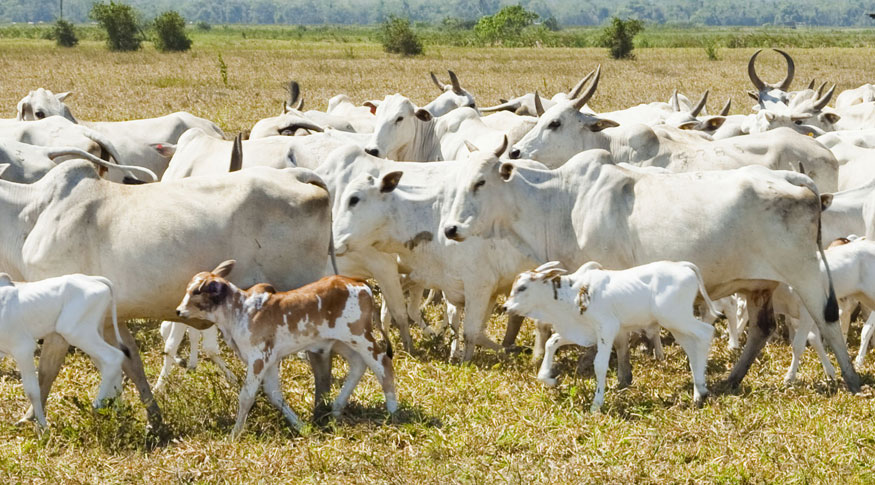
Cattle herd increased for the second consecutive year in 2020, after two years of decrease, according to the Municipal Livestock Production (PPM), a survey released today (29) by the IBGE. The production of cow milk also increased, and hit a record of 35.4 billion liters, 1.5% more than in the preceding year. The value of production reached R$ 56.2 billion.
In the case of cattle, the increase of 1.5% reached 218.2 million head, second biggest herd in the time series that started in 1974. The rise of live cattle and calf prices and the growth of exports of beef contributed to the increase of cattle in the year, since the product became more valuable.
“We had been through a period marked by the slaughter of females leading to reduction in the number of animals and calves. That has caused a rise in prices. Today the scenario indicates retention of female cattle. Instead of being slaughtered, they area used to get new offspring, thus recomposing herds,” says Mariana Oliveira, PPM supervisor.
São Félix do Xingú (PA) keeps the biggest cattle herd in the country
Mato Grosso is still on top of the ranking, with 32.7 million head of cattle, an increase of 2.3% against 2019. Among Major Regions, the biggest increase in absolute herd figures took place in the North: 5.5%, or 2.7 million head more, amounting to 52.4 million. The Central West accounted for 34.6% of the total (75.4 million).
The city of São Félix do Xingu (PA) is still the leader of the bovine ranking in Brazil, with 2.4 million head of cattle and an increase of 5.4% in the year.
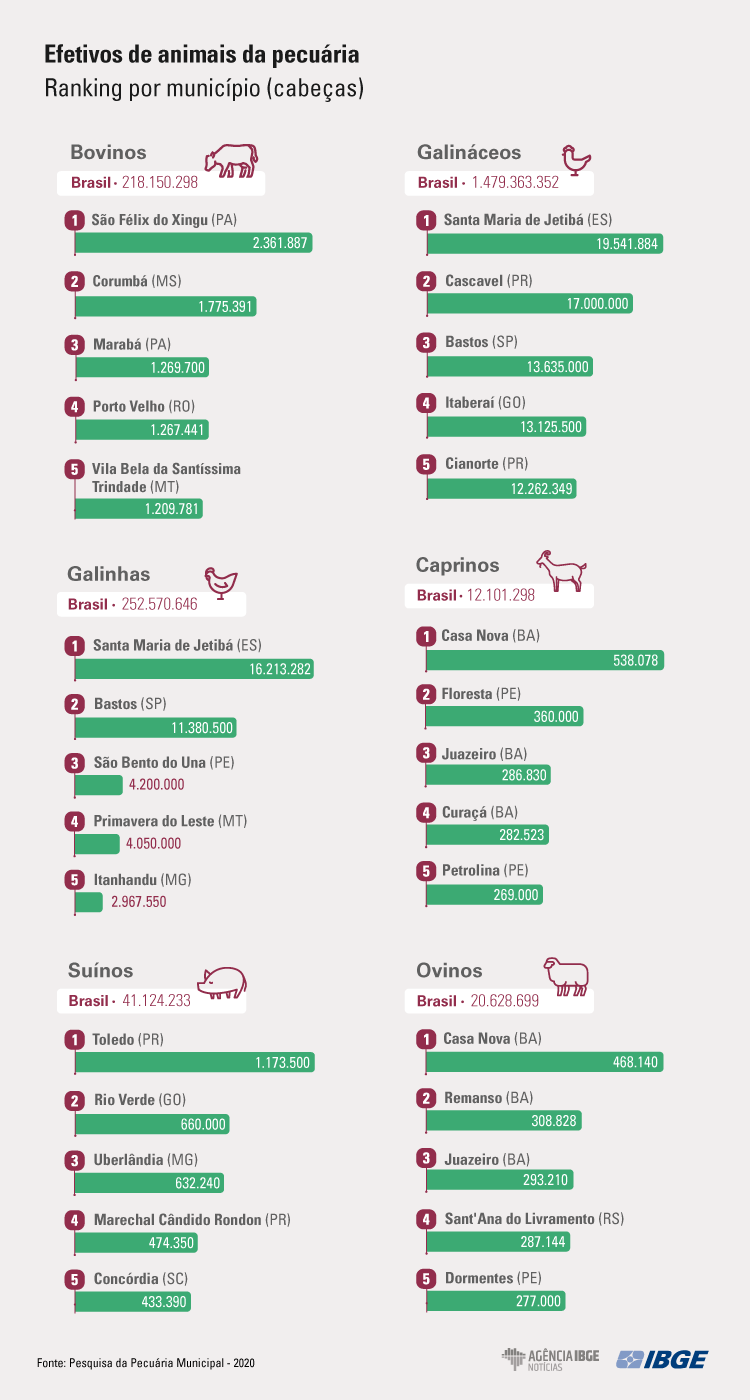
Value of livestock production increased by 2.7.1%, to R$ 75.45 billion
The value of production of the main agricultural products increased by 27.1% in 2020 and reached R$ 75.5 billion. Milk production accounted for 74.9& of the total, followed by production of hen eggs (23.6%), honey (0.8%), quail eggs (0.5%), wool (0.1%) and silkworm cocoons (0.1%). The Southeast region accounted for the highest value of production, with 36.3% of the total, followed by the South, with 31.9% (R$ 24.04 billion). Minas Gerais was the leader in terms of value of production: R$ 17.8 billion, with 89.8% of this amount (R$ 15.99 billion) coming from milk production.
With 35.4 billion liters, milk production hits a record in volume and price
Production of cow’s milk also grew in 2020, and reached 35.4 billion liters, an increase of 1.5% against the previous year. Value of production reached R$ 56.2 billion. This increase resulted from the gain in productivity, since the inventory of 16.2 million milked cows was 0.8% smaller against the previous year. Minas Gerais is still the leader regarding milk production: 9.7 billion liters or 27.3% of the national overall, with an increase of 2.6% a year.
Among the the ten main municipalities in this segment, seven are located in Minas Gerais, but Castro, in Paraná, was in the first position, accounting for 363.9 million liters, with an annual increase of 30.0% and value of production of R$ 651.4 million. In the second position was Carambeí (PR), with 224.8 million liters of milk, an increase of 24.9% in the year and a value of production of R$ 402.4 million. Patos de Minas (MG) fell to the third position, with 195.0 million liters (-0.4%, in the year) and with a value of production of R$ 352.9 million (an increase of 39.7%).
Herd of hogs and pigs increases by 1.4% and amounts to 41.1 million head
The herd of hogs and pigs increased by 1.4% in 2020, amounting to 41.1 million head. According to the survey supervisor, Brazil has the fourth biggest herd of hogs and pigs, and it is the major producer of pork and the fourth major exporter. The number of breeders recorded the third consecutive increase (1.4%) and reached 4.8 million head.
Santa Catarina was the leader among states with 7.8 million head, and an increase of 2.8% in the year. Among the municipalities, Toledo (PR) was the main producer, with 1.2 million hogs and pigs, or 2.9% of the national total. Rio Verde (GO), with 660.0 thousand head, and Uberlândia (MG), with 632.2 thousand, also stood out.
Production of eggs reaches 4.8 billion dozen and hits new record
The production of hen eggs increased by 3.5% and reached 4.8 billion dozen, with 83.1% from big and medieum sized farms, according to information from POG, IBGE’s survey on egg production. Having generated R$ 17.8 billion, production hit another record in the time series and, since 1999, has grown each year. “In 2020, mainly during the pandemic, eggs were consumed as a cheaper source of protein.” says Ms. Oliveira.
São Paulo remained as the main producer, responsible for 25.6% of the national production of eggs, followed by Paraná (94%) and Minas Gerais (8.5%). No changes were recorded by the main five producing municipalities: The top municipality was Santa Maria de Jetibá (ES), followed by Bastos (SP), Itanhandu (MG), Primavera do Leste (MT) and São Bento do Una (PE).
The survey also shows that the number of hens for egg production increased by 2.0%, adding up to 252.6 million. São Paulo had the biggest inventory, 21.4% of the national total, followed by Paraná (9.9%), Minas Gerais (8.3%), Rio Grande do Sul (7.9%) and Espírito Santo (7.2%). The three municipalities leading the ranking are Santa Maria de Jetibá (ES), Bastos (SP) and São Bento do Una (PE).
The total poultry – roosters, hens, chickens, pullets and chicks– amounted to 1.5 billion head, 1.5% bigger than in the previous year, with an increase of 21.7 million.
Production of honey grows by 12.5%, to 51.5 thousand metric tons
In 2020, the national production of honey reached 51.5 thousand metric tons, an increase of 12.5% against the previous year. Value of production also rose, to R$ 621.5 million. “Exports grew by 52.2%, since they were benefited by the rise of the dollar throughout 2020, which resulted in the supply of honey in the country. That led to a rise of the price, which added to the increase of 26.2% in value of production,” Mariana Oliveira explains.
The main producers are Paraná, responsible for 15.2% of the national total and Rio Grande do Sul, with 14.5%. In the Northeast, the highlights were Piauí, Bahia and Ceará, which accounted for 11.0%, 9.7% and 7.6% of the total in Brazil.
In 2020, Arapoti (Paraná) was responsible for the biggest production of honey. The municipality surpassed Ortigueira (PR) and Botucatu (SP), which are now second and third ones in the ranking, followed by Itatinga (SP) and Campo Alegre de Lourdes (BA).
Fish farming produced 551.9 thousand metric tons, led by Paraná
Fish farming also advanced 4.3%, and amounted to 551.9 thousand metric tons in 2019. The three main producing states recorded no changes: Paraná, with 25.4% of the national output; São Paulo (10.0%) and Rondônia (8.7%). Nova Aurora (PR), is still the main municipality in terms of production, accounting for 3.6% of the national output and for 14.0% of the state output.
With an increase of 6.1%, Tilapia is still the main species, and accounts for 62.3% of the total fish produced or for 343.6 thousand metric tons. The South Region is a highlight in terms of tilapia raising, and represents 48.2% of the total produced in the country in 2020. Tambaqui is the second most produced species, with 100.6 thousand metric tons, coming mainly from the North region (73.0% of the total).
RN and CE hold 68% of the shrimp production, which has increased for 3rd year in a row
Fish farming grew by 14.1% and output amounted to 63.2 thousand metric tons. Value of production reached R$ 1.3 million, an increase of 9.3% against 2019. The Northeast is the leader, with 99.6% of the producion in Brazil. Two highlights in this Major Region are Rio Grande do Norte (34.8%) and Ceará (33.2%). Aracati (CE), after two years as second main producer, went back to the first position, with 3.9 thousand metric tons, an increase of 31.1%. Pendências (RN), after two years as main producer, dropped 4.5% and is now in the second position, with an output of 3.7 thousand metric tons.



